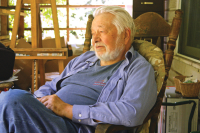Scenic beauty, yes, but what about things to do?
By Andre A. Rodriguez • Special to the Smoky Mountain News
A new travel study revealed potential visitors lack awareness about activities and attractions in Cherokee and the surrounding region, detering them from planning a visit.
“People don’t have a very good understanding of Western North Carolina and the things to see or do here,” said Rob Bell, interim executive director for the Blue Ridge National Heritage Area. “They’re aware of the scenic beauty and not aware of the activities.”
The study was aimed at increasing the effectiveness of tourism marketing on the Qualla Boundary and the seven counties of the Smoky Mountain Host region — Haywood, Jackson, Macon, Swain, Clay, Cherokee and Graham.
“We wanted to understand why people aren’t coming and if they had come what they liked and what they didn’t like,” said Bell. “What kind of things would motivate (visitors) to come?”
The study was commissioned by the Blue Ridge National Heritage Area and Smoky Mountain Host and funded by the Cherokee Preservation Foundation. Eastern Band of Cherokee Indians Travel and Promotion, Cherokee Chamber of Commerce, Western Carolina University and the Goss Agency were also partners in the study.
Related Items
The Marketing Workshop out of Norcross, Ga., based the study on 600 online interviews with adults who have inquired about the North Carolina Smoky Mountains within the past four years, online interviews with 600 residents within a 300 mile radius outside Western North Carolina who may or may not have visited the area, and 50 telephone interviews with Cherokee Chamber members whose businesses deal with tourists.
The study concluded Cherokee needed to improve the quality of dining options, nightlife and variety of things to do on the Qualla Boundary. Families are looking for more family-friendly activities, and adults desire more nightlife and other activities besides Harrah’s Cherokee Casino.
One of the things that stuck out for Bell — aside from the soft economy — was there were so many other places people wanted to visit. For example, they were looking for a vacation at the beach rather than one in the mountains.
Cherokee and the rest of the Smoky Mountain Host area would also benefit from improved perceptions of value for the money, which would have a significant impact on travelers the region seeks to draw, the study concluded. Most of visitors to the region are couples over the age of 55, according to the study, but the region seeks to draw more families with children.
Providing visitors and prospective visitors with sample itineraries and more education about activities in the area, along with package deals or a discount pass for the region, would help motivate more people to visit.
Bell said his organization is already at work on one of the study’s recommendations, which was to provide visitors and prospective visitors with sample itineraries.
“There’s a great hunger for sample itineraries,” Bell said. “We started preparing some that will soon go up on our Web site (www.blueridgeheritage.com).
“One thing that popped out to me with the study findings is people are planning their travel on a much shorter time frame. A lot of folks don’t have time to wait for material in the mail. They’re doing planning on the Internet and hopping in their cars and heading out that weekend or the next weekend. We need to be smarter about how we get the information out there about attractions and lodgings,” Bell said.
People are also interested in finding a good deal, such as area discount passes. The Blue Ridge National Heritage Area offers visitors the Go Blue Ridge card, which provides admission to up to 30 area attractions for two-, three- or five-day increments, including the Museum of the Cherokee Indian, Oconaluftee Indian Village and performances of Unto these Hills.
Bell anticipates more attractions will get on board with the Go Blue Ridge program.
The Blue Ridge National Heritage Area is also in the process of rebuilding its destination-marketing Web site.
“We’re taking the study findings to heart,” he said. “People want to know that there’s a variety of things to do in the area. The Web site makes it easier to access that information.”
Susan Jenkins, executive director of Cherokee Preservation Foundation, said she was encouraged by the study.
“Cherokee Preservation Foundation is pleased to have supported research that identifies opportunities to increase family visitation by providing more family activities and then making the presence of such activities known. The foundation has sponsored previous research about heritage tourism efforts undertaken by the Eastern Band of Cherokee Indians, and we are committed to helping the members of the tribe market Cherokee and continuously improve what the Qualla Boundary has to offer visitors,” Jenkins said.









